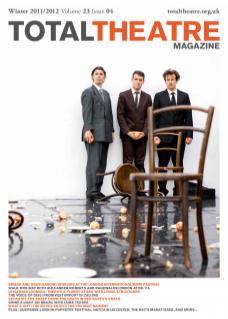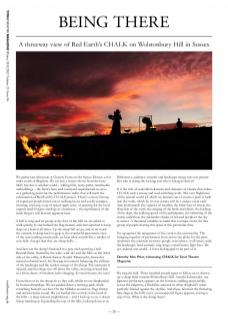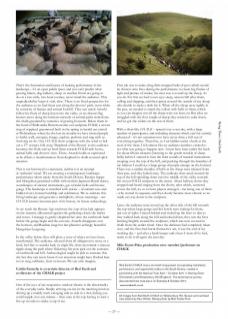We gather late afternoon at Chantry Farm on the Sussex Downs, a few miles north of Brighton. We are just a stone’s throw from the busy M23, but this is another world – rolling hills, stony paths, ramshackle outbuildings – the farm’s barn and courtyard requisitioned to serve as a gathering point for the performance-walks that will mark the culmination of Red Earth’s CHALK project. There’s a merry throng of expectant people kitted out in walking boots and woolly jumpers, chatting, enjoying a cup of spiced apple juice, or queuing for the local organic lamb burgers sizzling on a barbecue – the significance of the lamb burgers will become apparent later.
A bell is rung and we group at the foot of the hill: we are asked to walk quietly, to stay behind the flag-bearers, and most important to keep dogs on a lead at all times. Up the steep hill we go, and as we reach the summit, looking back to gasp at the wonderful panoramic view of the surrounding countryside, we hear what sounds like a medley of cow-bells. Except that they are sheep-bells…
And here are the sheep! Enclosed in a pen, each sporting a bell. Beyond them, framed by the wide, wide sky and the hills on the other side of the valley, is Butoh dancer Atsushi Takenouchi, dressed in natural-coloured wool, his flowing movements balancing the stillness of the landscape and the restless energy of the sheep. The enclosure is opened, and the sheep run off down the valley, weaving around him in a feisty dance of freedom, bells clanging. It’s total theatre, for sure!
From then on in, the sheep do as they will, whilst we are shepherded by human sheepdogs. We are guided down a twisting path, chalk crunching beneath our feet. On the hillsides around us, flags flutter and ancient horns sound. We are herded into a circle in the bowl of the hills – a large natural amphitheatre – and I look up to see a dozen sheep standing as if guarding the top of the hills, looking down at us. Performers, audience, animals and landscape merge into one picture. But who is doing the looking and who is being looked at?
It is the mix of controlled elements and elements of chance that makes CHALK such a strong and soul-enriching work. The very flightiness of the natural world (of which we humans are of course a part) is built into the work, which by its very nature will be a unique event each time ‘performed’: the vagaries of weather, the behaviour of sheep, the direction of the wind, the singing of the birds and choirs, the barking of the dogs, the walking speed of the participants, the skittering of the stones underfoot, the particular shades of red and purple in the sky at sunset. A thousand variables to make this a unique event, for this group of people sharing this space at this particular time.
Yet up against the uniqueness of the event is the universality. The bringing together of performers from across the globe for the piece reinforces the common territory: people everywhere, in all times, walk the landscape, herd animals, sing songs, sound horns, light fires. We are, indeed, one world – I leave feeling glad to be part of it.
Dorothy Max Prior, witnessing CHALK for Total Theatre Magazine
We ring the bell. Three hundred people agree to follow us, in silence, up a sheep field towards Wolstonbury Hill. Atsushi Takenouchi, our Japanese performer, appears on the horizon, striding purposefully across the ridgeway, a Neolithic ancestor in white shepherd’s robes perfectly framed against the skyline. And there, between the fluttering blue flags at the hill’s crest, an unexpected figure appears, waving a cup of tea. What is she doing there?
That’s the frustration and beauty of making performance in the landscape – it’s an open public space and you can’t predict what passing hikers, dog walkers, sheep or weather fronts are going to do on a two-mile, two-hour journey, never mind the audience. This unpredictability keeps it vital, alive. There is no fixed perspective for the audience as we lead them east along the drovers’ path, worn white by centuries of human and animal footfall. They can watch Atsushi follow his flock of sheep down into the valley, or six distant flag bearers move along the intricate network of animal paths etched into the chalk grassland by centuries of grazing livestock. Below them in the bowl of Wellcombe Bottom nestles our sculpture FOLD, a woven ring of coppiced greenwood built in the spring to herald our arrival at Wolstonbury where for the last six months we have invited people to build, walk, navigate, forage, explore, perform and sing with us. And sing we do. Our CHALK choir competes with the wind to belt out a 17th century folk song ’Shepherd of the Downs’ as the audience becomes the flock and we herd them towards FOLD with horns, animal bells and drovers’ cries. There, Atsushi holds us captivated as he effects a transformation from shepherd to chalk-covered spirit ancestor.
This is not historical re-enactment, neither is it an attempt at ‘authentic’ ritual. We are creating a contemporary landscape performance where music from the South Downs, Russian steppe and Mongolian grassland collide with modern Japanese Butoh dance, soundscapes of ancient instruments, gas cylinder bells and bronze gongs. The landscape is stratified with stories – of ancient seas and hidden rivers, human hardship and celebration. We re-animate this living landscape and generate a multiplicity of new meanings – our CHALK journey becomes part of its history, its future archaeology.
As we reach the Bronze Age enclosure the cup-of-tea lady appears on the summit, silhouetted against the gathering cloud; she smiles and waves. I manage to gently shepherd her onto the earthwork bank before the gongs begin and the sun sets, Atsushi disappears over the horizon, and Baadma sings her last plaintive achingly beautiful Mongolian Longsong.
In the valley below, fires still glow, a trace of where we have been, transformed. The audience, released from all obligation to move as a herd, feel free to wander back in single file, their movement a sinuous ripple along the path where flickering fire pots pick out the contours of earthwork and hill. Archaeologists might be able to excavate this site but they can never know if our ancestors might have flocked here too to sing, celebrate, feast or mourn. We can only imagine.
Caitlin Easterby is co-artistic director of Red Earth and co-director of the CHALK project
One of the joys of site-responsive outdoor theatre is the abnormality of the everyday tasks. Simply arriving on-site in the morning involves driving up a muddy track swinging side-to-side in a 4x4, feeling you could topple over any minute – then once at the top having to start a fire up in order to make a cup of tea.
First job was to make cling-film-wrapped balls of pyro which would be thrown onto fires during the performance to create big flashes of light and plumes of smoke; the next was to round up the sheep. As you do. For this we had to run up a steep, uneven hill after them, calling and clapping, and then sprint around the outside of any sheep who decide to make a dash for it. When all the sheep were tightly in the pen, we needed to attach the collars with bells to them, which as you can imagine not all the sheep were too keen on. But after we struggled with the first couple of sheep they started to calm down, and we got the collars on the rest of them.
With a show like CHALK – spread over a vast site, with a large number of participants, and including elements which can’t be entirely rehearsed – it’s not uncommon to have never done a full run of everything together. Therefore, as I sat hidden under a bush at the start of the show, I felt almost like an audience member, excited to see what was going to happen next. I must have been under the bush for about fifteen minutes (listening to the gentle twinkle of sheep bells) before I started to hear the faint sounds of musical instruments creeping over the top of the hill, and peeking through the branches of my hideout I could see a large group of people emerge on the horizon. There was a sudden thunder of bells as the sheep were released from their pen, and they bolted away. The audience then arced around the top of the hill spiralling down into the middle of the valley towards the woven FOLD sculpture in the centre. About halfway down they stopped and heard singing from the choirs, after which, scattered across the hill, six or so horn players emerged – me being one of them – who started in sequence and then slowly became more chaotic as we made our way down to the sculpture.
Later, the audience were moved up the other side of the hill towards the top where large gongs and fire bowls were waiting for them, just out of sight: I stayed behind and stoked up the fires so that as they walked back along the hill and looked down, they saw the fires burning brightly around the sculpture, which was now covered in chalk from the earlier ritual. Once the darkness had completely taken over, and the fires had burnt themselves out, it was the end of my working day – and after a lamb burger and a beer I went off to bed, ready to do it all again the next day.
Milo Foster-Prior, production crew member/performer on CHALK
Red Earth’s CHALK was a six-month-long project incorporating installation, performance, and experiential walks on the South Downs, created in partnership with the National Trust April – October 2011 in Harting Down (Chichester) and Wolstonbury Hill (Brighton). The performance journey documented here took place on Saturday 8 October 2011. www.redearth.co.uk


